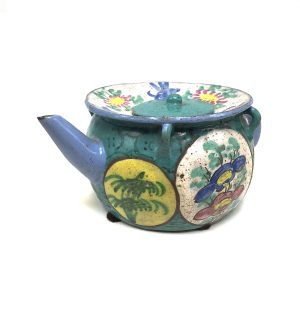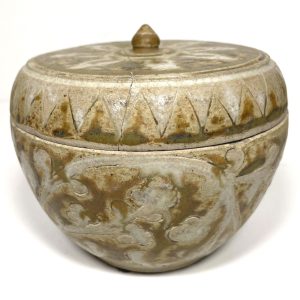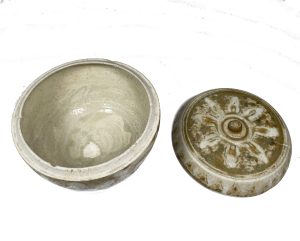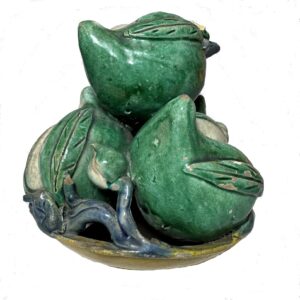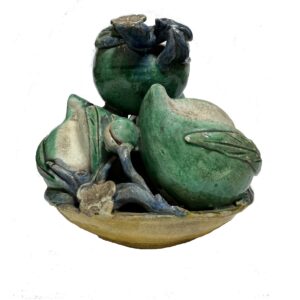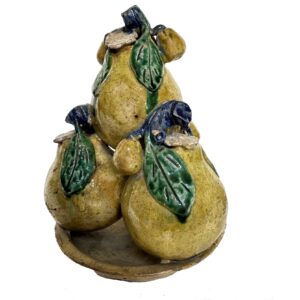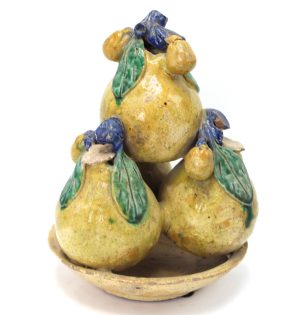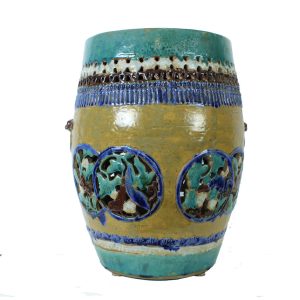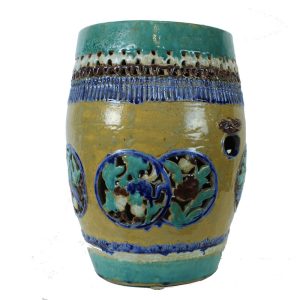Showing 1–12 of 15 results
-
Sale!


$185.00 Original price was: $185.00.$145.00Current price is: $145.00.
H: 7.125″ W: 8.375″ D: 3.75″ | FREE SHIPPING WITHIN CONTINENTAL U.S.
This Shiwan green chopsticks holder is divided into two parts with holes on top for hanging and small holes on the bottom for drainage. Chopsticks were often wedding gifts from mothers to daughters with many auspicious wishes: phrases for sons as soon as possible, upside down bats with coins and ribbon meaning “blessings in front of your eyes,” and border clouds and thunder symbolizing life-giving rain and abundance.
-
Sale!


$365.00 Original price was: $365.00.$295.00Current price is: $295.00.
H: 2.625” W: 6.125” D: 4” | FREE SHIPPING WITHIN CONTINENTAL U.S.!
This delicate antique Yixing teapot is unusually shaped with a loop handle, short spout, flaring rim, small flat cover and small loops below its rim that indicate it may have been used to suspend oil or soy sauce rather than serve tea. Its charm is enhanced by its free hand-painted colored enamels with 6 circular panels containing fanciful and bright floral and leaf decorations. Chinese tea connoisseurs consider Yixing teapots the best vessel for brewing tea as it is naturally porous to absorb oils released during brewing and improves tea’s flavor with continual use. Recommended for display only, it pairs well with 1152A-PAR Enameled Yixing Stoneware Teapot.
-
Sale!


$365.00 Original price was: $365.00.$295.00Current price is: $295.00.
H: 2.6 ” W: 6.1 ” D: 4 ” | FREE SHIPPING WITHIN CONTINENTAL U.S.!
This delicate antique Yixing teapot is unusually shaped with a loop handle, short spout, flaring rim, small flat cover and small loops below its rim that indicate it may have been used to suspend oil or soy sauce rather than serve tea. Its charm is enhanced by its free hand-painted colored enamels with 6 circular panels containing fanciful and bright floral and leaf decorations. Chinese tea connoisseurs consider Yixing teapots the best vessel for brewing tea as it is naturally porous to absorb oils released during brewing and improves tea’s flavor with continual use.
-


$1,450.00
The top design on this stoneware garden stool is a simplified open narcissus with a white and yellow center; it is a symbol of good fortune and prosperity. Below are intertwined double lozenges, followed on the lowest register of by white octagonal shapes and ending with a low orange-yellow rectangle pierced in the center. A…
-
Sale!


$235.00 Original price was: $235.00.$185.00Current price is: $185.00.
H: 7.25″ W: 5″ D: 5″ | FREE SHIPPING WITHIN CONTINENTAL U.S.!
This five-sided Shiwan stoneware pillow with slanted top, open bottom, vibrant glazed surface, and etched coin and diamond design was used for smoking opium as the cool shell cradled the users’ heads and necks and offset the warmth of smoking and the hollow inside stored valuables. We have another which can be paired with it. If a candle is placed inside it emits an amazing shadowy form of a coin, which appealed to those in an opium state.
-
Sale!


$395.00 Original price was: $395.00.$285.00Current price is: $285.00.
H: 9″ W: 8.375″ D: 5.5″ | CALL 213-568-3030 OR EMAIL [email protected] FOR SHIPPING COST
This very attractive antique green glazed teapot is typical of the stoneware pottery made in the Shiwan kilns in Guangdong during the 18-19th century. Finely designed, this hexagonal pot has a yoked rounded handle with spiral decorations that adds a delightful touch. The pieces are well known for their brilliant flambé—or flame-like quality – glazes such as apple green glaze of this pot.
-
Sale!


$295.00 Original price was: $295.00.$215.00Current price is: $215.00.
Ht: 4.25” Dia: 5” | FREE SHIPPING within continental U.S.!
This Sawankhalok glazed stoneware lidded bowl with radiating glazed petals, olive-brown glazed lotus bud handle, intricate scroll of white glazed branches and florals was used to store spices, powders and cosmetics, betel nuts and medicine.
-
Sale!


$450.00 Original price was: $450.00.$295.00Current price is: $295.00.
Ht: 5.5” Dia: 6” | FREE SHIPPING WITHIN CONTINENTAL U.S.
Shiwan stoneware peaches and lotuses on footed bowl auspicious symbols associated with springtime, fertility, long healthy life for many generations and therefore are propitious gifts for birthdays, especially for the elderly.
-
Sale!


$375.00 Original price was: $375.00.$295.00Current price is: $295.00.
H: 8.75″ DIA: 6.75 ” | FREE SHIPPING WITHIN CONTINENTAL U.S.!
Shiwan stoneware glazed sculptures of fruit symbolizing life and new beginnings to place on temple or home altar. They augment plates of fresh stacked fresh fruit to honor ancestors. These pears symbolize long life.
-
Sale!


$265.00 Original price was: $265.00.$215.00Current price is: $215.00.
H: 4” W: 5.25” D: 3.5” | FREE SHIPPING WITHIN CONTINENTAL U.S.
This delicate Meiji single serving Kyo Ware teapot with a high handle ,like all antique Kyo pieces was hand thrown and hand-painted. This small, striking teapot was fired to create a luminescent beige color with a crackled glaze resulting in a glowing radiance and has the Kiyomizu kiln seal where it was made on the bottom. The chrysanthemum (kiku in Japanese) in a basket in blue and red on the body and lid symbolizes longevity and rejuvenation. . Production of Kyo ware is limited, making it highly collected worldwide.
-


$1,275.00
Most antique Chinese outdoor garden stools were made in a drum or barrel shape using common ceramic designs like decorative fretwork, low relief decoration, simple pierced schemes, a variety of underglaze painted images, and calligraphyand fired in kilns. The upper border of the body of this beautiful stoneware garden stool is covered with four color…
-


$1,275.00
Most antique Chinese outdoor garden stools were made in a drum or barrel shape using common ceramic designs like decorative fretwork, low relief decoration, simple pierced schemes, a variety of underglaze painted images, calligraphy and more. The upper border of the body of this beautiful stoneware garden stool is covered with four color bands that…
End of content
End of content






